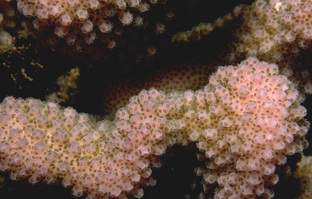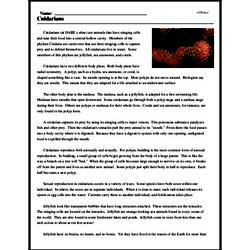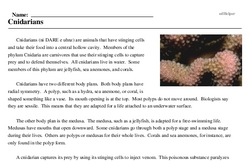Cnidarians
Cnidarians (ni DARE e uhnz) are animals that have stinging cells and take their food into a central hollow cavity. Members of the phylum Cnidaria are carnivores that use their stinging cells to capture prey and to defend themselves. All cnidarians live in water. Some members of this phylum are jellyfish, sea anemones, and corals.
Cnidarians have two different body plans. Both body plans have radial symmetry. A polyp, such as a hydra, sea anemone, or coral, is shaped something like a vase. Its mouth opening is at the top. Most polyps do not move around. Biologists say they are sessile. This means that they are adapted for a life attached to an underwater surface.
The other body plan is the medusa. The medusa, such as a jellyfish, is adapted for a free-swimming life. Medusas have mouths that open downward. Some cnidarians go through both a polyp stage and a medusa stage during their lives. Others are polyps or medusas for their whole lives. Corals and sea anemones, for instance, are only found in the polyp form.
A cnidarian captures its prey by using its stinging cells to inject venom. This poisonous substance paralyzes fish and other prey. Then the cnidarian's tentacles pull the prey animal to its "mouth." From there the food passes into a body cavity where it is digested. Because they have a digestive system with only one opening, undigested food is expelled through the mouth.
Cnidarians reproduce both asexually and sexually. For polyps, budding is the most common form of asexual reproduction. In budding, a small group of cells begin growing from the body of a large parent. This is like the way a branch on a tree will "bud." When the group of cells becomes large enough to survive on its own, it breaks off from the parent and lives as another new animal. Some polyps just split their body in half to reproduce. Each half becomes a new polyp.




